Investigation into Hydraulic Fracture Propagation Behavior during Temporary Plugging and Diverting Fracturing in Coal Seam
Abstract
:1. Introduction
2. Experimental Equipment and Procedures
2.1. Specimen Preparation
2.2. Experimental Equipment
2.3. Experimental Procedures
3. Experimental Results and Analysis
3.1. Effect of Horizontal Stress Difference
3.2. Effect of the Concentration of TPA
3.3. Effect of the Particle Size of TPA
4. Conclusions
- (1)
- Temporary plugging and diverting fracturing is an effective technique to increase the complexity of hydraulic fracture in coal seam. In this study, the hydraulic fracture generated during the PF tended to propagate along direction of the maximum horizontal stress under different stress states. The injection of TPA can significantly promote the generation of THFs.
- (2)
- When the particle size of TPA was 20/40 mesh, blockage in the wellbore tended to occur; when the particle size of TPA was 70/100 mesh, the TPA was widely distributed within the primary fracture, which failed to form effective plugging and consequently restricted the generation of THFs. Reasonable particle size (40/70 mesh) of TPA can ensure the entry of TPA into the primary fracture and form effective plugging, which is conducive to the generation of THFs.
- (3)
- With the concentration of TPA increasing from 20 g/L to 60 g/L, the plugging effectiveness was significantly enhanced. Both the diverting distance and the complexity of hydraulic fractures increased. However, under the high concentration of 60 g/L, the TPA tended to accumulate and block in the wellbore, resulting in an abnormally high breakdown pressure. On one hand, this abnormally high breakdown pressure could overcome the containment of stress state in fracture propagation path. On the other hand, it may cause the failure of hydraulic fracturing treatment.
Author Contributions
Funding
Institutional Review Board Statement
Informed Consent Statement
Data Availability Statement
Conflicts of Interest
References
- Huang, S.; Liu, W.; Zhao, G. Current status and development trend of China’s CBM development and utilization. J. China Coal Soc. 2009, 35, 5–10. [Google Scholar]
- Shan, X.; Zhang, S.; Li, A. Analysis of fracture propagation law of coalbed methane wells. Nat. Gas Ind. 2005, 1, 161–163. [Google Scholar]
- Cao, X.; Zhu, Y.; Wang, D. Occurrence characteristics and gas-controlling geological factors of coalbed methane in Zhengzhuang block. Coal Geol. Prospect. 2011, 39, 16–42. [Google Scholar]
- Zhao, X.; Zhu, Q.; Sun, F. Practice and thinking on exploration and development of high-rank coalbed methane in Qinshui Basin. J. China Coal Soc. 2015, 40, 2131–2136. [Google Scholar]
- Zhao, X.; Yang, Y.; Sun, F. High-rank coalbed methane accumulation rules and exploration and development technologies in the southern Qinshui Basin. Pet. Explor. Dev. 2016, 43, 303–309. [Google Scholar] [CrossRef]
- Gomaa, A.M.; Nino-Penaloza, A.; Castillo, D.; McCartney, E.; Mayor, J. Experimental Investigation of Particulate Diverter Used to Enhance Fracture Complexity. In Proceedings of the SPE International Conference and Exhibition on Formation Damage Control, Lafayette, LA, USA, 24–26 February 2016. SPE-178983-MS. [Google Scholar]
- Rassenfoss, S. Getting more from fracturing with diversion. J. Pet. Technol. 2017, 69, 42–47. [Google Scholar] [CrossRef]
- Bell, G.J.; Jones, A.H. Coal seam hydraulic fracture propagation on a laboratory scale. In Proceedings of the 1989 Coal-Bed Methane Symposium, Tuscaloosa, AL, USA, 17–20 April 1989; Volume 8994, pp. 17–20. [Google Scholar]
- Abass, H.H. Experimental observations of hydraulic fracture propagation through coal blocks. In Proceedings of the SPE Eastern Regional Meeting, Columbus, OH, USA, 31 October–2 November 1990. [Google Scholar]
- Deng, G.; Wang, S.; Huang, B. Study on the behavior of hydraulic crack propagation in coal and coal. Chin. J. Coal Mech. Eng. 2004, 23, 3489–3493. [Google Scholar]
- Du, C. The Theory and Application of Coal Seam Hydraulic Fracturing. Ph.D. Thesis, China University of Mining and Technology, Beijing, China, 2008. [Google Scholar]
- Yang, J.; Wang, Y.; Li, A. Experimental study on the law of coal and coal hydraulic crack propagation. J. China Coal Soc. 2012, 37, 73–77. [Google Scholar]
- Zou, Y. Simulation of Hydraulic Fracture Propagation in Coal Seams. Ph.D. Thesis, China University of Petroleum, Beijing, China, 2011. [Google Scholar]
- Cheng, Y.; Xu, T.; Wu, B. Experimental study on fracture morphology of coal and coal hydraulic fracturing. Nat. Gas Geosci. 2013, 24, 134–137. [Google Scholar]
- Zhang, Y.; Zhang, S.; Liu, Y. Experimental study on crack propagation law of coal and coal hydraulic fracturing. China Coal Geol. 2015, 27, 21–25. [Google Scholar]
- Huang, G.; Liu, W.; Wang, X. Application of Fracture Turning Fracturing Technology in Xinjiang Oilfield. Xinjiang Pet. Sci. Technol. 2008, 3, 21–24. [Google Scholar]
- Dai, J.; Zhong, S.; Xiong, J. Research and application of temporary plugging and fracturing technology in Pingbei Oilfield. Drill. Prod. Technol. 2006, 29, 67–69. [Google Scholar]
- Wu, Y.; Chen, F.; Cheng, N. Using manual temporary plugging and steering to improve the effect of repeated fracturing. Drill. Prod. Technol. 2008, 31, 59–61. [Google Scholar]
- He, C.M.; Shi, S.Z.; Zhong, K.W.; Chen, J.; Jiang, W.; Cheng, N. Performance Evaluation of Water Soluble Diverter Agent and its Temporary Plugging Effect in Refracturing. In Proceedings of the IOP Conference Series: Earth and Environmental Science, Xiamen, China, 1–3 March 2018; Volume 188, p. 012071. [Google Scholar]
- Liu, S.; Guo, T.; Rui, Z.; Ling, K. Performance Evaluation of Degradable Temporary TPA in Laboratory Experiment. J. Energy Resour. Technol. 2020, 142, 123002. [Google Scholar] [CrossRef]
- Ma, X.; Zou, Y.; Li, N.; Chen, M.; Zhang, Y.; Liu, Z. Experimental study on the mechanism of hydraulic fracture growth in a glutenite reservoir. J. Struct. Geol. 2017, 97, 37–47. [Google Scholar] [CrossRef]
- Zou, Y.; Gao, B.; Zhang, S.; Ma, X.; Sun, Z.; Wang, F.; Liu, C. Multi-fracture nonuniform initiation and vertical propagation behavior in thin interbedded tight sandstone: An experimental study. J. Petrol. Sci. Eng. 2022, 213, 110417. [Google Scholar] [CrossRef]
- Liu, G.H.; Pang, F.; Chen, Z.X. Similarity criterion in hydraulic fracturing simulation experiments. J. Univ. Pet. 2000, 05, 45–48. [Google Scholar]
- Olson, J.E.; Taleghani, A.D. Modeling simultaneous growth of multiple hydraulic fractures and their interaction with natural fractures. In Proceedings of the SPE Hydraulic Fracturing Technology Conference, The Woodlands, TX, USA, 19 January 2009. SPE 119739. [Google Scholar]
- Wang, Y.; Yuan, L.; Ren, J. Research and application progress of temporary plugging agents for steering fracturing. Sci. Technol. Eng. 2017, 17, 196–204. [Google Scholar]
- Su, L.; Pang, P.; Da, Y. Optimization and field test of TPA dosage for temporary plugging and repeated fracturing in low permeability oilfields. Fault Block Oil Gas Field 2014, 21, 114–117. [Google Scholar]
- Li, N.; Zhang, S.; Ma, X. Experimental study on the propagation law of hydraulic fractures in glutenite reservoirs. Chin. J. Coal Mech. Eng. 2017, 36, 2383–2392. [Google Scholar]
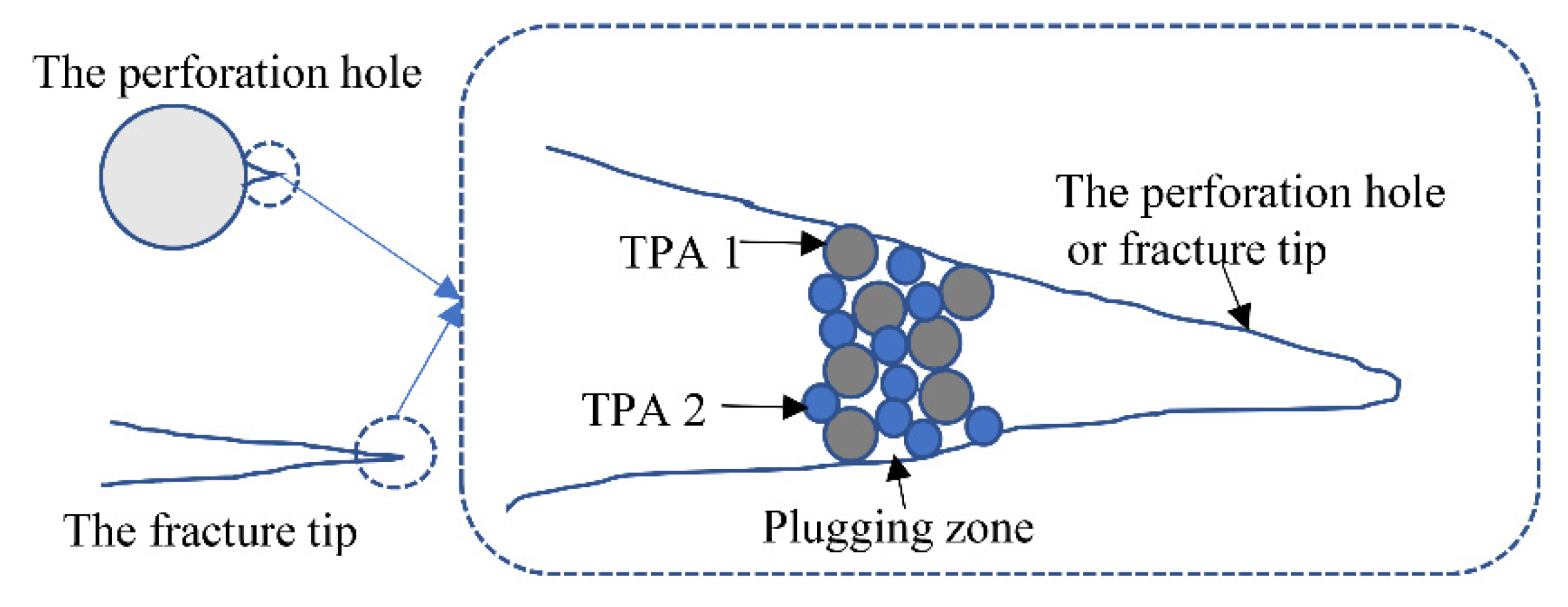

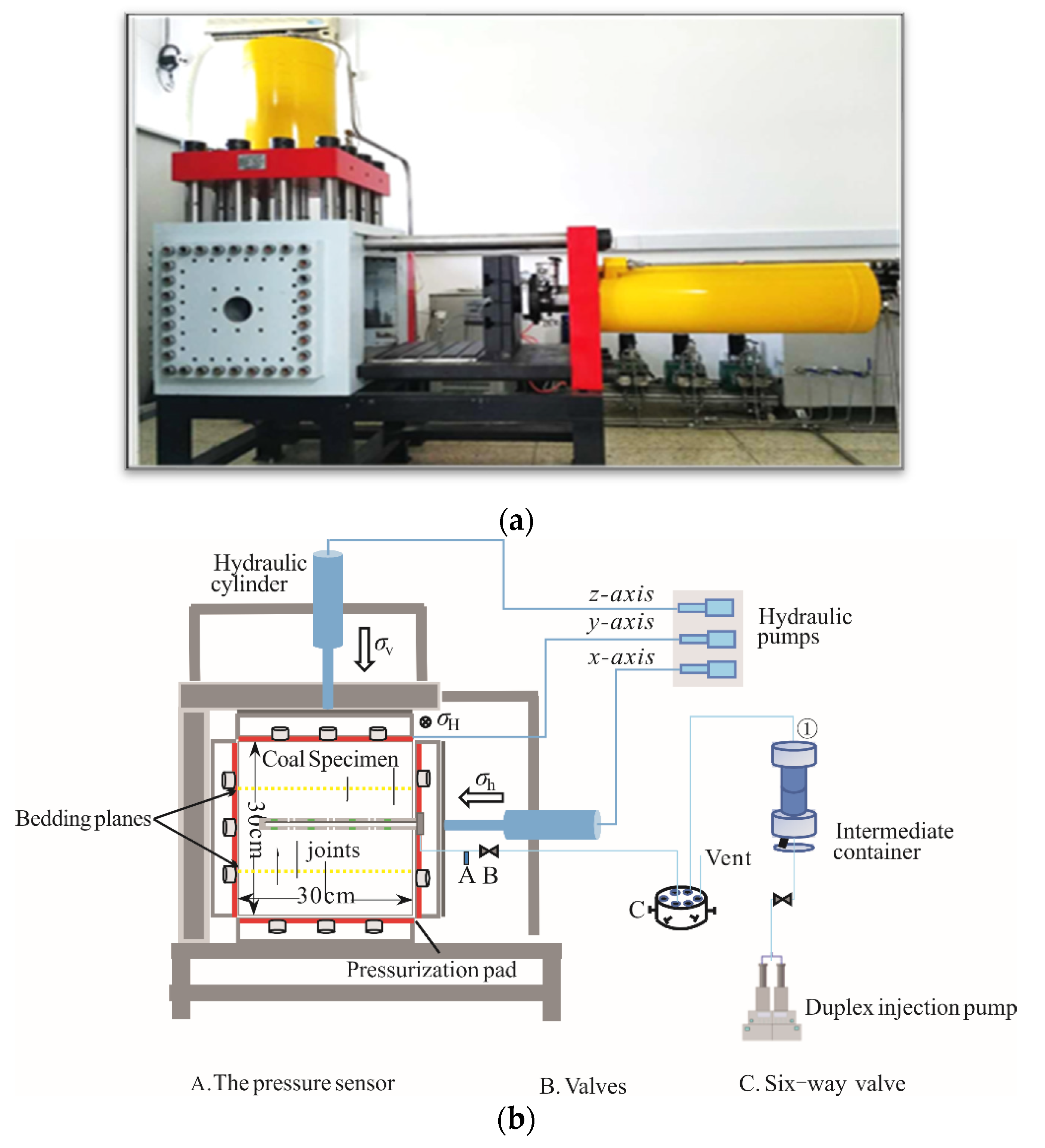

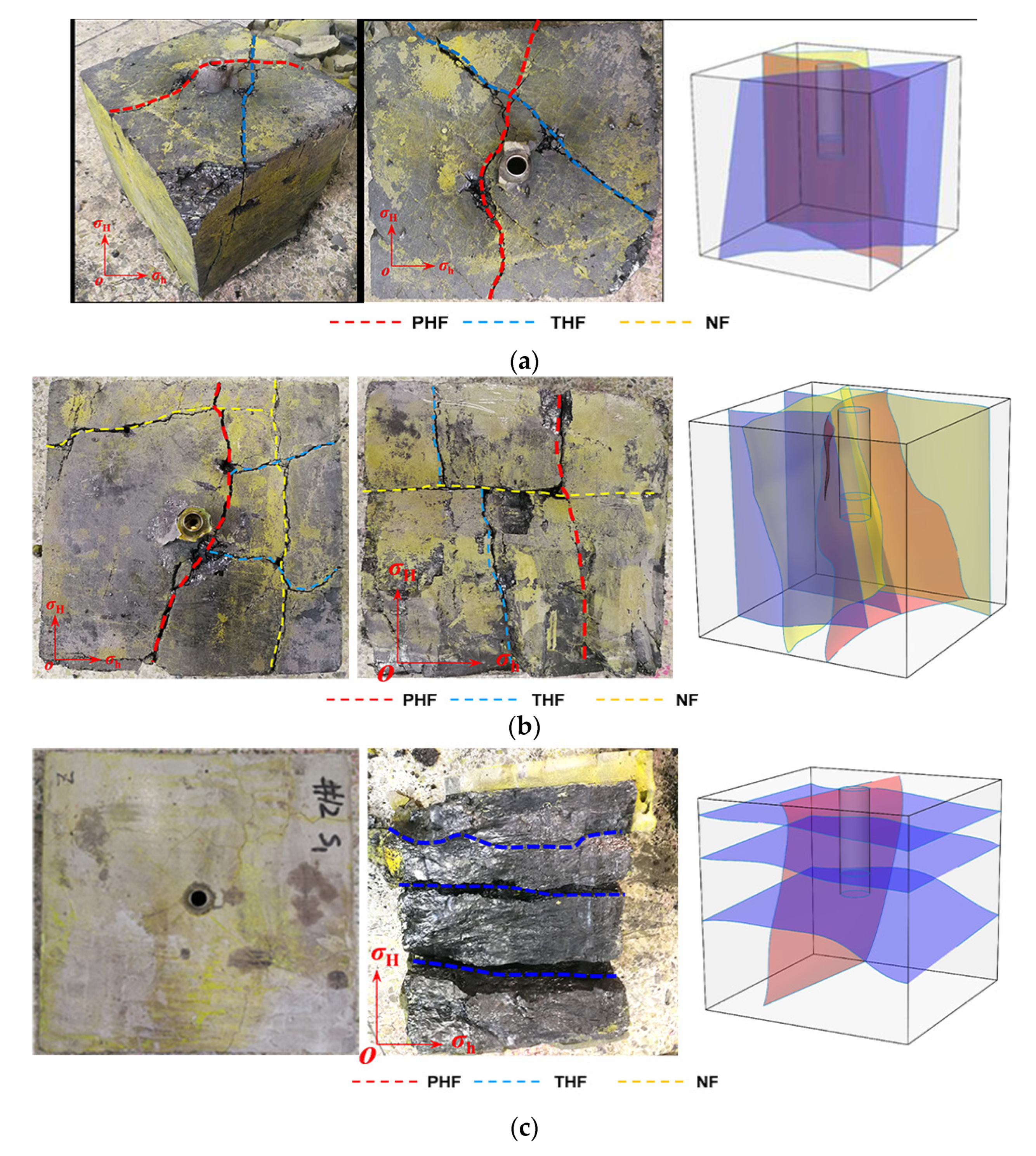
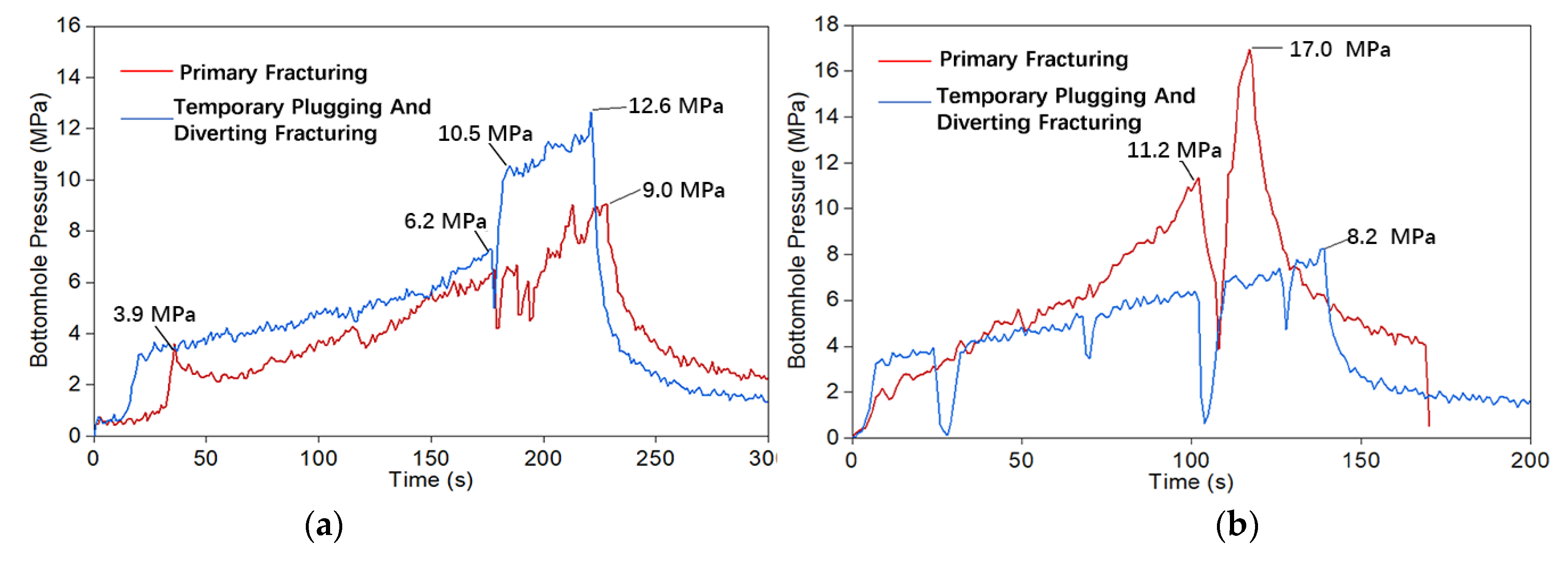
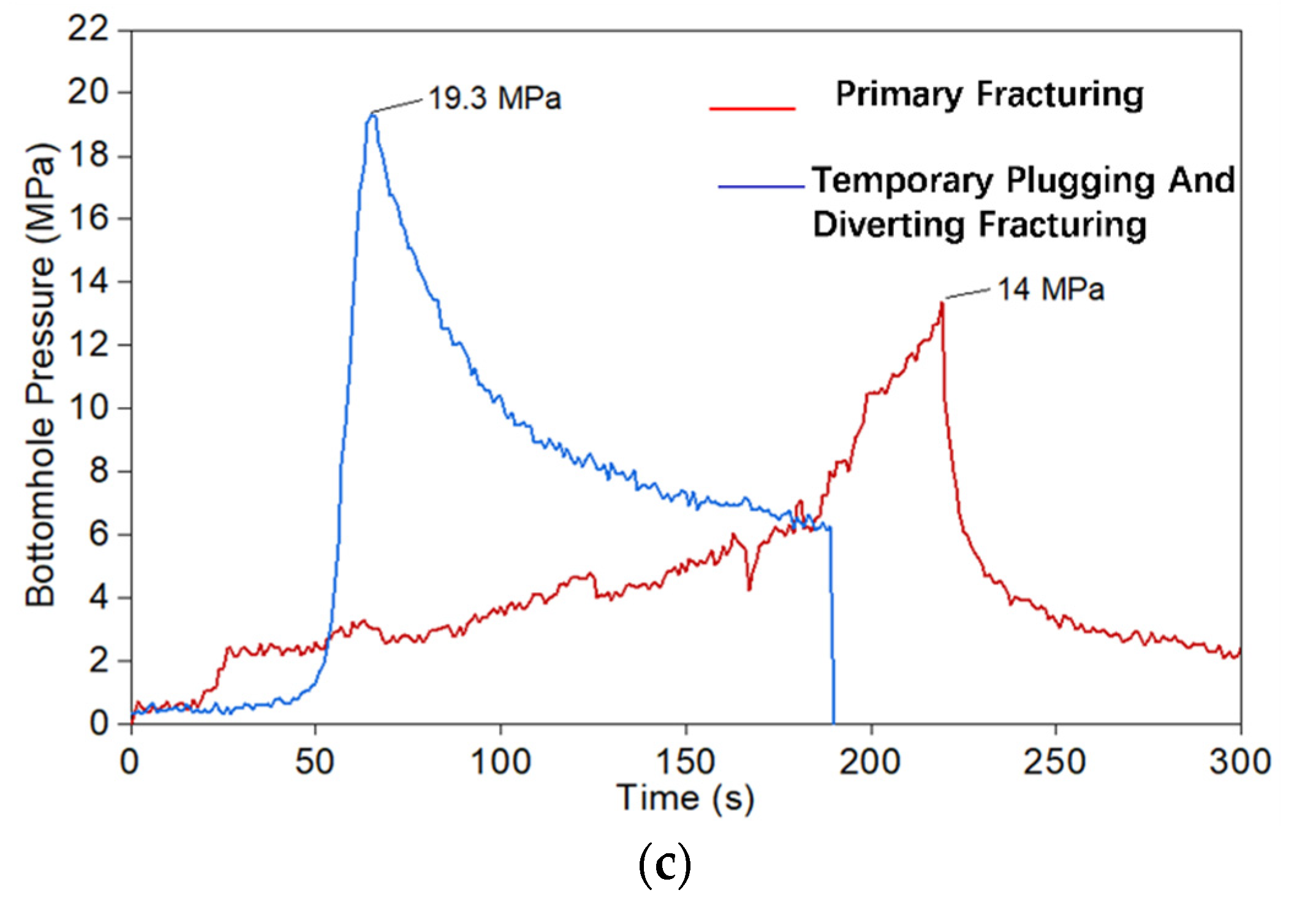
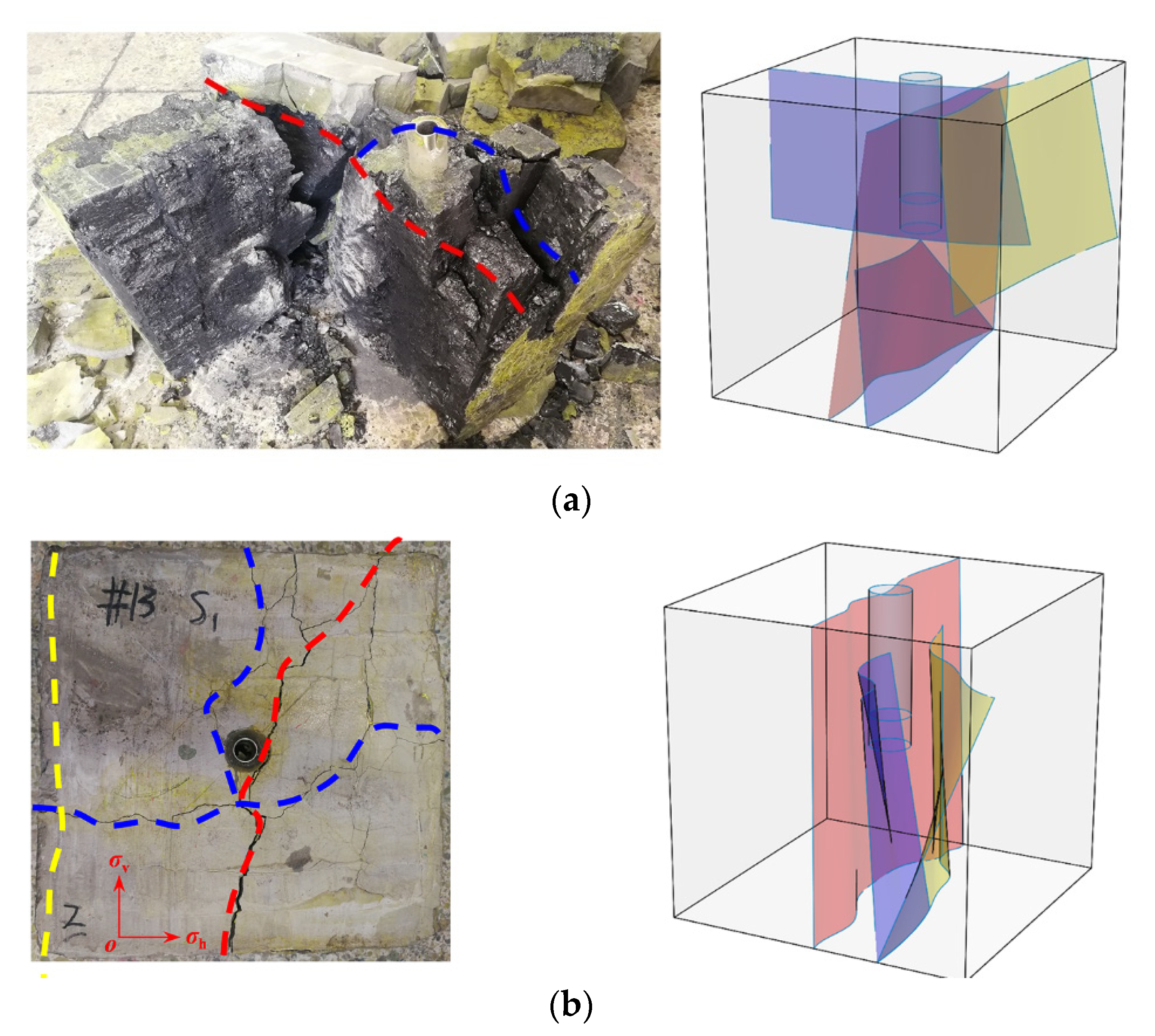
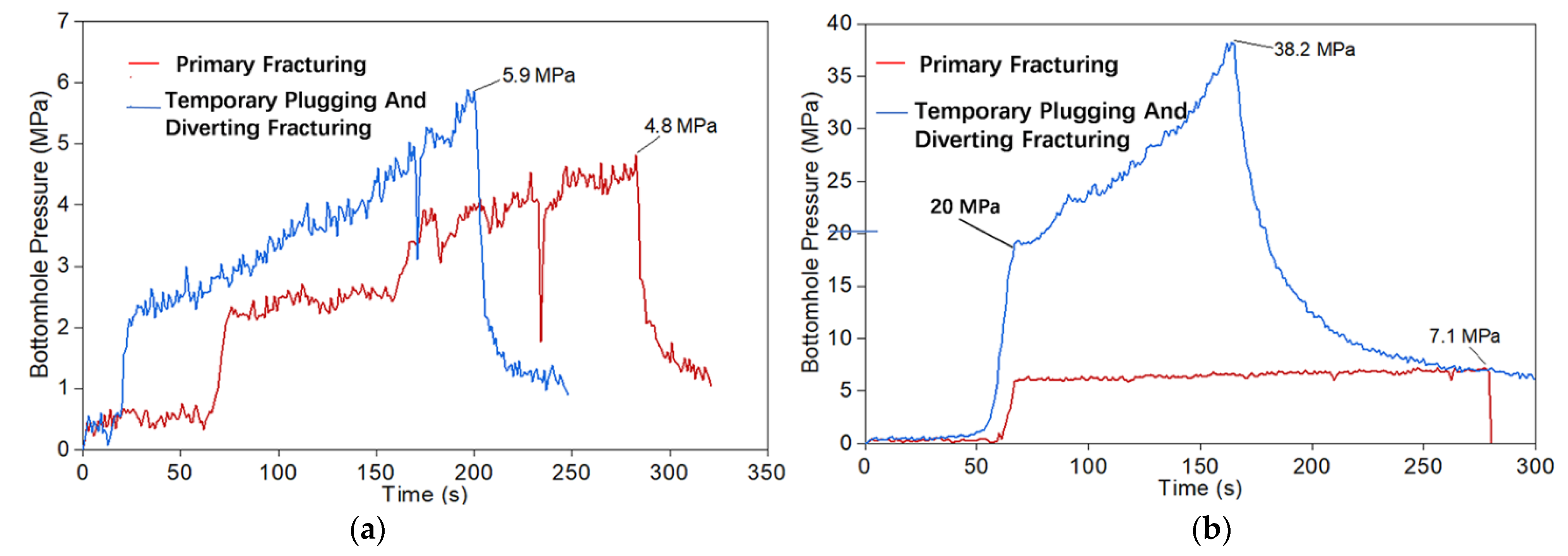

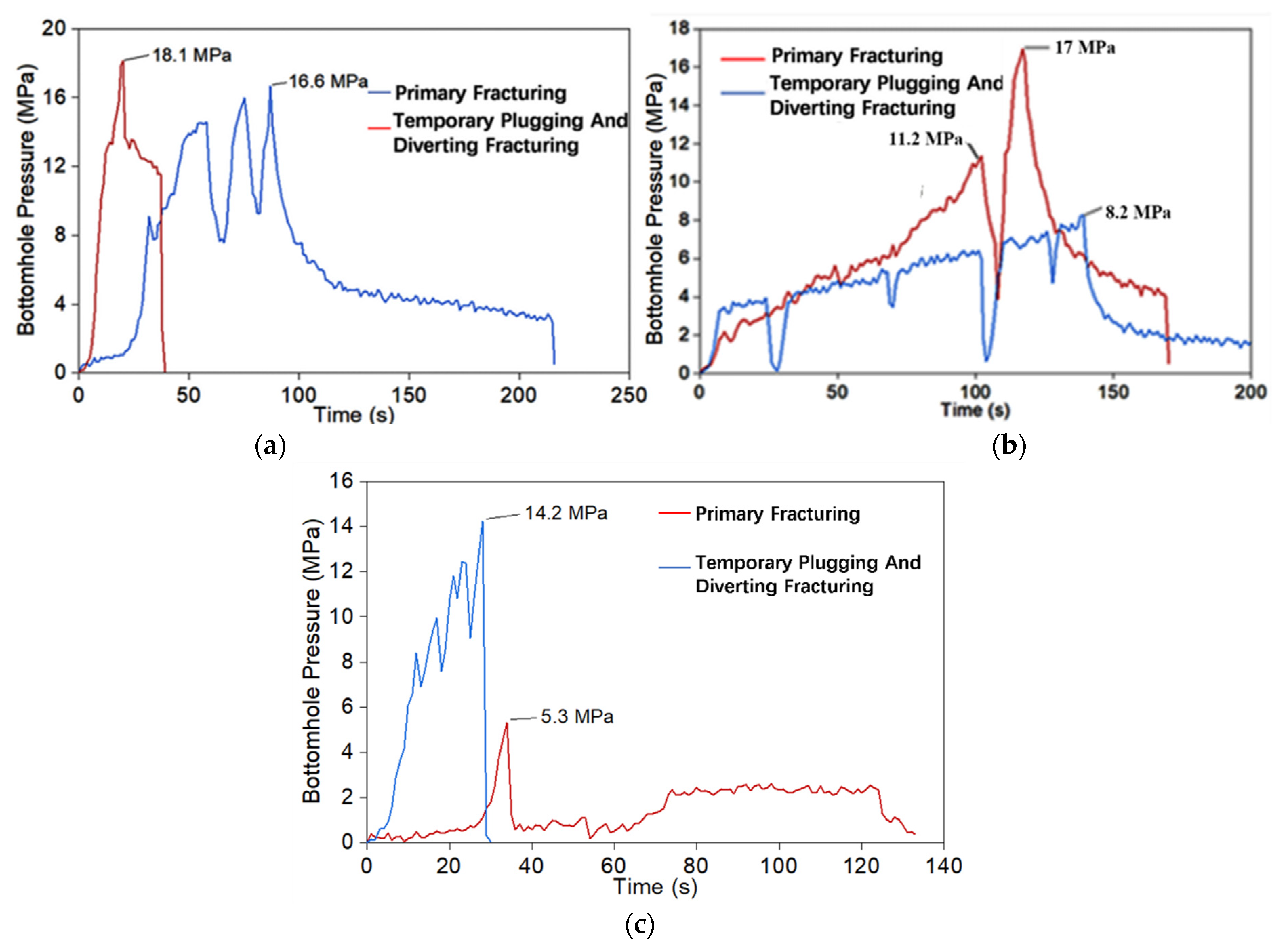
| Specimen Number | σv, σH, σh (MPa) | Injection Rate (mL/min) | Concentration of TPA (g/L) | Size of TPA (Mesh) |
|---|---|---|---|---|
| 1# | 12, 7, 5 | 300 + 300 | 40 | 40–70 |
| 2# | 12, 9, 5 | 300 + 300 | 40 | 40–70 |
| 3# | 12, 11, 3 | 300 + 300 | 40 | 40–70 |
| 4# | 12, 9, 5 | 300 + 300 | 20 | 40–70 |
| 5# | 12, 9, 5 | 300 + 300 | 60 | 40–70 |
| 6# | 12, 9, 5 | 300 + 300 | 40 | 20–40 |
| 7# | 12, 9, 5 | 300 + 300 | 40 | 80–120 |
Publisher’s Note: MDPI stays neutral with regard to jurisdictional claims in published maps and institutional affiliations. |
© 2022 by the authors. Licensee MDPI, Basel, Switzerland. This article is an open access article distributed under the terms and conditions of the Creative Commons Attribution (CC BY) license (https://creativecommons.org/licenses/by/4.0/).
Share and Cite
Zou, Y.; Gao, B.; Ma, Q. Investigation into Hydraulic Fracture Propagation Behavior during Temporary Plugging and Diverting Fracturing in Coal Seam. Processes 2022, 10, 731. https://doi.org/10.3390/pr10040731
Zou Y, Gao B, Ma Q. Investigation into Hydraulic Fracture Propagation Behavior during Temporary Plugging and Diverting Fracturing in Coal Seam. Processes. 2022; 10(4):731. https://doi.org/10.3390/pr10040731
Chicago/Turabian StyleZou, Yushi, Budong Gao, and Qimiao Ma. 2022. "Investigation into Hydraulic Fracture Propagation Behavior during Temporary Plugging and Diverting Fracturing in Coal Seam" Processes 10, no. 4: 731. https://doi.org/10.3390/pr10040731
APA StyleZou, Y., Gao, B., & Ma, Q. (2022). Investigation into Hydraulic Fracture Propagation Behavior during Temporary Plugging and Diverting Fracturing in Coal Seam. Processes, 10(4), 731. https://doi.org/10.3390/pr10040731







